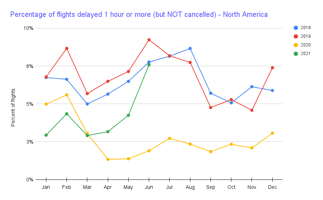I'm ecstatic that we're starting to fly again. The travel industry has taken a beating, and it's...
Driving Traveler Satisfaction: Adelman Travel integrates Lumo's API
The negative impacts of flight delays and disruptions are well documented. Globally, flight delays are estimated to cost over 60 billion USD, and in the U.S. two out of every three flight delays are caused by somewhat predictable events, such as weather, air traffic control restrictions, or another forecastable cause. Most critical for travel agencies and travel management companies (TMCs) is the personal impact on the traveler: over half of all business travelers list delays and cancellations as the most frustrating part of travel.
Adelman Travel CIO Ivan Imana was looking to solve a major problem when he first heard of Lumo’s predictive flight alerts back in August 2017—“We needed to provide a solution to the negative impacts of flight disruptions on travelers.”
Finding a solution to this problem was central to Adelman’s company-wide objective to provide travelers with “the best experience possible.” That meant not only providing accurate, real-time updates like gate changes and flight notifications from the airlines (cancellations, delays, etc.) but “the ability to be proactive related to their business travel plans.”
“Before I met with Lumo, we were using another provider [for flights alerts], but what impressed me when I met with the Lumo team in 2017 was the broader vision they had in not only providing the basics in a very reliable way, but using predictive analytics to take this critical technology to the next level,” said Imana.
That first meeting in 2017 developed into a partnership that today gives all Adelman travelers access to Lumo's predictions via Adelman’s AVA (Adelman Virtual Assistant) mobile app. AVA is currently being rolled out to travelers and has about 20,000 users to date, with plans to have it out to every end-user with Adelman Travel, around 300,000 to 400,000 in total, within the next six months.
“The feedback has been fantastic,” said Imana. “Everyone has really loved the proactive information, that it’s driven by artificial intelligence, and it updates real time—all of that has been received very well by our client base.”
Travelers have also shared their personal experiences. “A classic example we recently had is from a client that had a ‘red’ notification on the app, which is how we display a high likelihood of a delay of two hours or more,” shared Imana. “On their airline mobile app, and when they checked in online, it was showing that their flight was going to be on time. Because of the information provided by Lumo in AVA, this customer was able to get a hotel in the city where they were connecting and reschedule their meeting for the next day. That original flight was ultimately canceled.”
Business travelers are going to a destination for a business reason. If it’s to meet with a client or a potential partner and that meeting is critical, the negative impacts of flight delays and disruptions can reach well beyond the individual. On the other hand, delays and disruptions can negatively impact an employee’s personal life (such as arriving late or missing an important family event).
“One of the concerns we had was how quickly the information would be available to users in the app. Fortunately, that’s something we’ve had a very positive experience with,” said Imana. “It’s a testament to how strong the APIs are. If I’m using my mobile app, and I’m calling up Lumo, it comes back instantaneously. As an end-user, you don’t even notice it—all you notice is that one second your flight was rated a three and the next second you’re a six. For us, that makes for a great end-user experience.”





